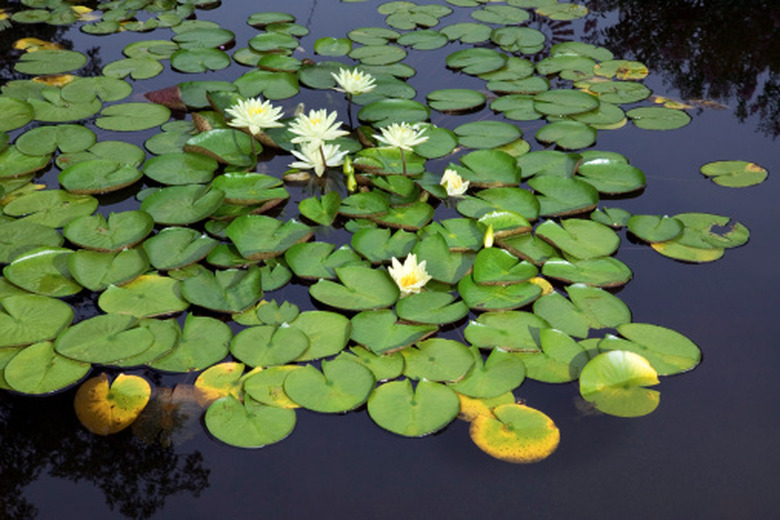How Does The Stem Of A Water Lily Help It Grow In A Pond?
Water lilies and other aquatic plants are prized for their appearance in their natural watery habitats, as well as in water gardens and other ornamental plantings. Water lilies have many unique adaptations that allow them to thrive in ponds and other wetlands. These include several leaf and root characteristics. Additionally, water lily stems offer adaptations that allow these plants to thrive in the water.
Stem Length
The water lily stems, or petioles, which connect the floating leaves to roots anchored at the bottom, are usually longer than necessary to allow the floating leaves to reach the water surface. This extra length allows the plant to quickly and easily adjust to fluctuating water levels. If a water level rises above leaves or the lily is placed deeper in the water, the stem will begin growing until the leaves are again at the surface. Long stem length also allows the many leaves on each plant to spread out on the water surface to take maximum advantage of sunlight and air.
- Water lilies and other aquatic plants are prized for their appearance in their natural watery habitats, as well as in water gardens and other ornamental plantings.
- Long stem length also allows the many leaves on each plant to spread out on the water surface to take maximum advantage of sunlight and air.
Weak and Flexible Nature
The stems, or petioles, of water lilies are week and flexible. There is little or no mechanical strengthening tissue in the stems. These plants will hang limply if they are removed from the water. Stems are supported by the water that surrounds them, and their flexibility allows them to withstand water currents and level changes.
Gas-Conducting Tissue
Water lily roots require oxygen but, unlike terrestrial plants, they cannot capture air from soil space. Instead, water lilies have air move into the internal gas spaces of young leaves. In addition to the standard conducting tissue that moves fluids between roots and leaves, water lilies and other aquatic plants have gas-conducting tissue that runs through the stem. This tissue is known as aerenchyma or lacunae. When young leaves are heated it creates a slight pressure that forces gas down through the aerenchyma. Older leaves lose their ability to pressurize the air so waste gas from the roots return through the gas-conducting stem tissue to exit through older leaves.
- The stems, or petioles, of water lilies are week and flexible.
- In addition to the standard conducting tissue that moves fluids between roots and leaves, water lilies and other aquatic plants have gas-conducting tissue that runs through the stem.
Centrally Arranged Vascular Tissue
The vascular tissue of water lilies is centrally arranged. In terrestrial plants, the phloem and xylem are arranged cylindrically towards the outside of the stem. The centrally-located vascular tissue allows the water lily stem to withstand the force of moving water.
References
- Coastal Carolina University; Plant Adaptations
- "Complete Guide to Water Garden Plants"; Helen Nash, Steve Stroupe and Perry Slocam; 1998
- "Micscape" Magazine; Plant Adaptations; Anne Bruce
- Offwell Woodland and Wildlife Trust; Plant Adaptations to Aquatic Life
